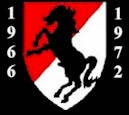|
Home | Photos |Facebook| Taps
HonorRoll | Base Camp | Reunions
Absent Comrades | Contributor's Corner
The Use Of Armor
In Vietnam
by Brian RossPage 2
The Role of Armor Armor has many roles in normal warfare. These range from seizing ground, shocking the enemy command and control structure, supporting infantry, destroying enemy AFV's and through to finally counter-attacking enemy attacks. In counter-insurgency warfare and in Vietnam in particular it was found that those roles expanded considerably to include such tasks as convoy protection, asset protection and other internal security tasks.It was though, the ability of armored units to bring to bear relatively large, massive amounts of fairly discriminatory firepower that was extremely mobile, was the major reason why all participants in the war turned to its use. Reading through any battle history of the war one comes across accounts time and time again of where armored units were able to basically decimate their opponents because of the amount of firepower they were able to bring to bear quickly against them whilst being protected by their own armor plating.
The US Army, in particular had a long history in WWII and Korea of the aggressive use of armor and this carried over to Vietnam where by its ability to force the pace and outmaneuver the enemy units were of considerable value. However, as Starry points out, whereas in previous wars armored units had been used as the forces which probed and outflanked the enemy, in Vietnam, "armor was used as a fixing force," essentially engaging the enemy and bringing him to battle, "while air mobile infantry became the encircling maneuver element."(14)
Whereas the French, in the previous Indochina war, against the communist Viet Minh had suffered severe casualties within their armored units whenever they had been ambushed, the US and allied forces found that usually, "the armored force, led by tanks, had sufficient combat power to withstand the massed ambush until supporting artillery, air, and infantry could brought in to destroy the enemy."(15) So throughout the war, engagements for armored forces usually took place with the armor forcing or creating the fight, often through invasion of the enemy's "safe areas" and infantry being used to reinforce or encircle were typical.
Perhaps the only real success for armor from the outset amongst the Americans and ARVN was the way in which mounted combat came to the fore for infantry in the form of the ACAV (Armored Cavalry Assault Vehicle). Until Vietnam, the US Army's doctrine had been that infantry units should dismount before assaulting an enemy position. However, as the ARVN discovered, this meant that when facing the massive amounts of firepower that the NLF or VPA could bring to bear during a firefight, the infantry was exposed to needless casualties, as well as losing the momentum of the attack.(16) Indeed it was the ARVN which pioneered the use of mounted tactics from APC's when they first deployed the M113 in 1962. They were also the first to discover the need for increased firepower on the vehicle by mounting an extra .30 Cal. MMG beside the commander, fired by an exposed prone soldier lying on the roof of the vehicle. Perhaps more importantly, they also discovered the vulnerability of the exposed track commander when manning the pintle mounted .50 Cal. HMG during the battle of Ap Bac where 14 out of 17 commanders became casualties.(17)
The US Cavalry units, perhaps smarting under the loss of their beloved tanks, took to the idea and improved upon it by creating the ACAV. They added armor around the commander and a gun shield for the .50 Cal., provided two extra M60 GPMG's each athwart the roof hatch (protected by shields) and installed an M79 Grenadier inside the troop compartment, firing through the roof hatch to provide close support. The result was a vehicle which was able to go where tanks weren't, by virtue of its lighter weight and ground pressure, packed considerable firepower and was agile and reasonably well armored. The result, when coupled with the aggressive leadership and tactics of the US Cavalry's commanders was highly effective by all accounts.
US Army tanks only encountered VPA tanks once during the entire war and that was at the Ben Het special forces camp in 1969 when VPA PT76 light tanks, supported by BTR50 APC's attacked the 1st Battalion, 69th Armor which was helping defend the camp in the Central Highlands of II Corps, with ARVN infantry. The battle occurred at night and the training and night-fighting equipment of the US tanks quickly showed their superiority. Although, because of the basic uncertainty of ever encountering VPA armor had resulted in the M48's of the US unit carrying too few HEAT (High-Explosive Anti-Tank) or AP (Armor- Piercing) rounds to complete the destruction of the enemy vehicles (they had, in the closing stages of the battle to resort to the use of HE rounds), it demonstrated that the M48 in competent hands was very much still a potent anti-armor weapon.(18)
The Australian experience was similar, although due to the political constraints of Australia's involvement, the size of the units involved were usually much smaller. Indeed, the entire deployment of Australian forces to Vietnam never amounted to much more than a heavily reinforced infantry Brigade at its height, while its armor elements never amounted to more than a squadron of APC's and a squadron of Centurion tanks.
As a consequence, whereas American armored units often operated independently of infantry formations, the squadron of tanks and APC's which were part of the Australian Task Force operated primarily in close cooperation and support of the infantry force within the Task Force. In particular, their operations during 1968, in and around the Firebases Coral and Balmoral were notable, as was the attack on Bin Ba in June 1969. The Australians also experimented with the concept of mounted cavalry combat towards the end of the war but it never really gained favor in what was essentially an infantry dominated army.(19)
The ARVN, on the other hand, hampered by its lack, until late in the war, of any MBT's, found its armored units more often than not being employed on security duties. An exception to this was the disastrous Operation Lam Son 719 during which ARVN units, supported by American forces (primarily Engineers and helicopters) attacked the VPA enclaves inside Laos near the border with South Vietnam in an effort to cut the Ho Chi Minh Trail and decrease infiltration. During this operation, the ARVN's units equipped with M41 Walker Bulldog light tanks undertook the tasks normally allocated to MBT's and performed reasonably well but suffered losses from enemy infantry AT weapons. When they did encounter enemy T54's during this operation the M41 proved itself quite able to deal with the heavier enemy tank. Something which was later confirmed in the final offensive of 1975 when M41's took on T54's in the streets of Cholon and Saigon.
Another exception was the Easter Offensive by the VPA in 1972. Here, the ARVN and VPA armored forces encountered one another for the first time at the battle of Dong Ha on 27 March. The ARVN 20th Tank Regiment had only received their M48's a few months earlier from US Army stocks (they were, by all accounts rather worn examples too). The 20th Tank Regiment itself was an unusual organization which, because of the experience of Lam Son 719, where AFV's had proven vulnerable to individual AT weapons, the ARVN Joint General Staff had decreed that the 20th Tank Regiment was to have additional infantry assigned to it in the form of a Rifle Company of tank riders, who's job it was to ride on the outside of the vehicles and provide protection during battle to the tanks.(20)
The 20th Tank Regiment proved itself up to the task and successfully defended Dong Ha and destroyed a large number of VPA armored vehicles, including T54's, PT76's and BTR50's. However, the Easter offensive was also notable for the introduction of a fearsome new weapon by the VPA: the anti-tank missile (in fact the AT-3 Sagger), some 18 months before their usually credited mass use during the Yom Kippur war in the Middle East. The 20th Tank Regiment lost several vehicles to the Saggers, the ARVN tankers seemingly, "fascinated by the missile's slow and erratic flight"(21) before they worked out tactics to counter it.
Indeed, the VPA's experience during the war, as already mentioned was one of learning many of the lessons that the other major combatants had learnt in previous wars. This meant numerous mistakes but as armor was not a major combat arm, these mistakes resulted in only what were in the main temporary setbacks. In particular there was the Easter Offensive of 1972, where air power played a significant role in blunting the VPA's armored thrusts. From this was learnt that organic air defenses were needed and in 1975, a considerable number of ZSU-57-2 and ZSU-23-4 AA tanks and SA-7 Strela SAM's were provided.
page 2 of 3
Home | Base Camp | Photos |
Guest Book | Taps | Contributor's Corner
Honor Roll | Links | Feed Back | Reunions | Search | Site Map


